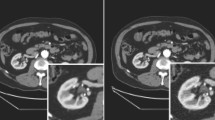Abstract
Maximum intensity projection (MIP) displays the voxel with the maximum intensity along the viewing ray, and this offers simplicity in usage, as it does not require a complex transfer function, the specification of which is a highly challenging and time-consuming process in direct volume rendering (DVR). However, MIP also has its inherent limitation, the loss of spatial context and shape information. This paper proposes a novel technique, shape-enhanced maximum intensity projection (SEMIP), to resolve this limitation. Inspired by lighting in DVR to emphasize surface structures, SEMIP searches a valid gradient for the maximum intensity of each viewing ray, and applies gradient-based shading to improve shape and depth perception of structures. As SEMIP may result in the pixel values over the maximum intensity of the display device, a tone reduction technique is introduced to compress the intensity range of the rendered image while preserving the original local contrast. In addition, depth-based color cues are employed to enhance the visual perception of internal structures, and a focus and context interaction is used to highlight structures of interest. We demonstrate the effectiveness of the proposed SEMIP with several volume data sets, especially from the medical field.
Similar content being viewed by others
References
Behrens, U., Ratering, R.: Adding shadows to a texture-based volume renderer. In: VVS ’98: Proceedings of the 1998 IEEE Symposium on Volume Visualization, pp. 39–46. ACM, New York (1998)
Bruckner, S., Gröller, M.E.: Enhancing depth-perception with flexible volumetric halos. IEEE Trans. Vis. Comput. Graph. 13(6), 1344–1351 (2007)
Bruckner, S., Gröller, M.E.: Instant volume visualization using maximum intensity difference accumulation. Comput. Graph. Forum 28(3), 775–782 (2009)
Correa, C., Ma, K.L.: Size-based transfer functions: A new volume exploration technique. IEEE Trans. Vis. Comput. Graph. 14(6), 1380–1387 (2008)
Debevec, P.E., Malik, J.: Recovering high dynamic range radiance maps from photographs. In: SIGGRAPH ’97: Proceedings of the 24th Annual Conference on Computer Graphics and Interactive Techniques, pp. 369–378. ACM/Addison-Wesley, New York (1997)
Díaz, J., Vázquez, P.: Depth-enhanced maximum intensity projection. In: 8th IEEE/EG International Symposium on Volume Graphics, pp. 93–100 (2010)
Drago, F., Myszkowski, K., Annen, T., Chiba, N.: Adaptive logarithmic mapping for displaying high contrast scenes. Comput. Graph. Forum 22(3), 419–426 (2003)
Durand, F., Dorsey, J.: Fast bilateral filtering for the display of high-dynamic-range images. ACM Trans. Graph. 21(10), 257–266 (2002)
Ebert, D., Rheingans, P.: Volume illustration: non-photorealistic rendering of volume models. In: VIS ’00: Proceedings of the conference on Visualization ’00, pp. 195–202. IEEE Computer Society, Los Alamitos (2000)
Hauser, H., Mroz, L., Bischi, G.I., Gröller, M.E.: Two-level volume rendering. IEEE Trans. Vis. Comput. Graph. 7(3), 242–252 (2001)
Heidrich, W., McCool, M., Stevens, J.: Interactive maximum projection volume rendering. In: Proceedings of the 6th Conference on Visualization ’95, pp. 11–18. IEEE Computer Society, Washington (1995)
Kindlmann, G.: Transfer function in direct volume rendering: design, interface, interaction. In: ACM SIGGRAPH Course Notes (2002)
Kindlmann, G., Whitaker, R., Tasdizen, T., Moller, T.: Curvature-based transfer functions for direct volume rendering: Methods and applications. In: VIS ’03: Proceedings of the 14th IEEE Visualization 2003, pp. 513–520. IEEE Computer Society, Washington (2003)
Kniss, J., Kindlmann, G., Hansen, C.: Multidimensional transfer functions for interactive volume rendering. IEEE Trans. Vis. Comput. Graph. 8(3), 270–285 (2002)
Kniss, J., Premoze, S., Hansen, C., Shirley, P., McPherson, A.: A model for volume lighting and modeling. IEEE Trans. Vis. Comput. Graph. 9(2), 150–162 (2003)
Ledda, P., Chalmers, A., Troscianko, T., Seetzen, H.: Evaluation of tone mapping operators using a high dynamic range display. ACM Trans. Graph. 24(3), 640–648 (2005)
Max, N.: Optical models for direct volume rendering. IEEE Trans. Vis. Comput. Graph. 1(2), 99–108 (1995)
Mora, B., Ebert, D.S.: Low-complexity maximum intensity projection. ACM Trans. Graph. 24(4), 1392–1416 (2005)
Mroz, L., Hauser, H., Gröller, M.E.: Interactive high-quality maximum intensity projection. Comput. Graph. Forum 19(3), 341–350 (2000)
Nagy, Z., Schneider, J., Westermann, R.: Interactive volume illustration. In: Proceedings of Vision, Modeling and Visualization 2002, pp. 497–504 (2002)
Rezk-Salama, C., Hadwiger, M., Ropinski, T., Ljung, P.: Advanced illumination techniques for GPU volume ray-casting. In: ACM SIGGRAPH, Course Notes 2009 (2009)
Ropinski, T., Steinicke, F., Hinrichs, K.: Visually supporting depth perception in angiography imaging. In: Lecture Notes in Computer Science, vol. 4073, pp. 193–104 (2006)
Sato, Y., Shiraga, N., Nakajima, S., Tamura, S., Kikinis, R.: LMIP: Local maximum intensity projection: Comparison of visualization methods using abdominal CT-angiography. J. Comput. Assist. Tomogr. 22(6), 912–917 (1998)
Straka, M., Cervenanský, M., Cruz, A.L., Köchl, A., Srámek, M., Gröller, M.E., Fleischmann, D.: The vesselglyph: Focus and context visualization in CT-angiography. In: IEEE Visualization, pp. 392–385 (2004). Commission for Scientific Visualization, Austrian (2004)
Svakhine, N.A., Ebert, D.S., Andrews, W.M.: Illustration-inspired depth enhanced volumetric medical visualization. IEEE Trans. Vis. Comput. Graph. 15(1), 77–86 (2009)
Wallis, J., Miller, T., Lerner, C., Kleerup, E.: Three-dimensional display in nuclear medicine. IEEE Trans. Med. Imaging 8(4), 297–230 (1989)
Yuan, X., Nguyen, M.X., Chen, B., Porter, D.H.: High dynamic range volume visualization. In: Proceedings of the Conference on Visualization, pp. 327–334. IEEE Computer Society, Washington (2005)
Yuan, X., Nguyen, M.X., Chen, B., Porter, D.H.: HDR VolVis: High dynamic range volume visualization. IEEE Trans. Vis. Comput. Graph. 12(4), 433–445 (2006)
Author information
Authors and Affiliations
Corresponding authors
Rights and permissions
About this article
Cite this article
Zhou, Z., Tao, Y., Lin, H. et al. Shape-enhanced maximum intensity projection. Vis Comput 27, 677–686 (2011). https://doi.org/10.1007/s00371-011-0570-2
Published:
Issue Date:
DOI: https://doi.org/10.1007/s00371-011-0570-2




